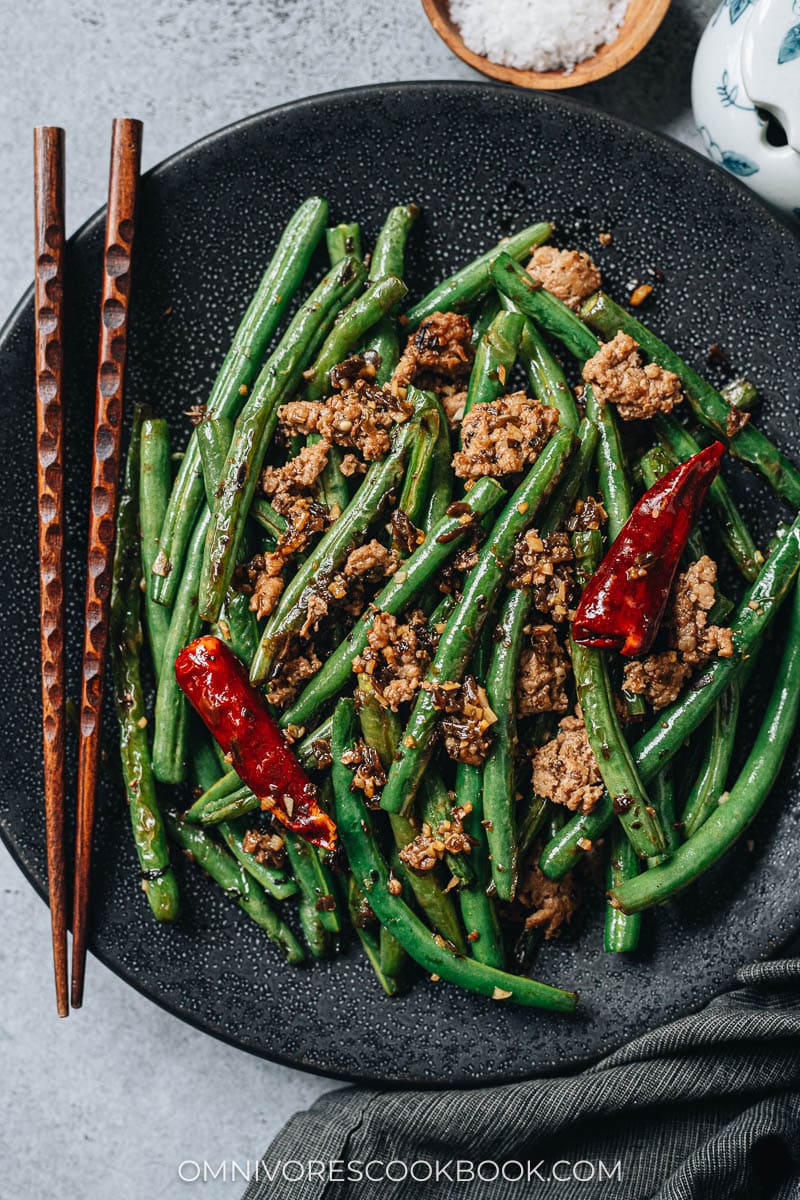
Sichuan dry fried green beans, or Gan Bian Si Ji Dou (干煸四季豆), is a famous traditional Sichuan dish. The fresh green beans are roasted in a pan until blistered and beautifully charred, then tossed with ground pork, pickled mustard greens, ginger, garlic, chili peppers, Sichuan peppercorns, soy sauce, and wine for a rich and fragrant taste.
It is one of my favorite ways to cook green beans because it gives them a heavenly texture and a rich taste that goes so well with rice, and in my opinion, it also works fantastic as a side for Asian Thanksgiving recipes including my juicy slow roasted turkey legs.
When I would host foreign colleagues and friends back in China, I took countless people to experience real Sichuan food. The Mala Chicken and Dan Dan Noodles might be the most famous ones. But at the end of the day, vegetable dishes like these dry fried green beans and Sichuan Eggplant always won everybody over and became their new favorite Chinese vegetable stir fry recipes.

Dry fried green beans ingredients
Sui Mi Ya Cai
Sui Mi Ya Cai (碎米芽菜), or Sichuan Sichuan fermented pickled mustard greens, is the secret ingredient that makes this dish very authentic.
The mustard greens are hand pickled, sliced, and dried. Then they are seasoned with salt and packed into ceramic pots to ferment for three to six months. After the first fermentation, they are boiled with brown sugar for eight to nine hours and then hung out to dry once more. In the final stage, these greens are sealed again with star anise, Sichuan peppercorns, and other spices, for another three to six months.
The ingredient adds sweetness and a super umami to a dish to make it irresistible.
You can find Sui Mi Ya Cai at most Chinese markets and online.
If you have Sui Mi Ya Cai, it’s very easy to turn dry fried green beans into a vegan / vegetarian dish without compromising on flavor.
However, if you do not have this ingredient, I highly recommend adding ground meat to the dish to boost the flavor.
Mise en place
When you’re ready to cook, your table should have:
- Prepped green beans
- Ground meat
- Aromatics (ginger, garlic, dried chili pepper)
- Ground Sichuan peppercorns
- Sui Mi Ya Cai
- Seasonings (Shaoxing wine, soy sauce and sugar)
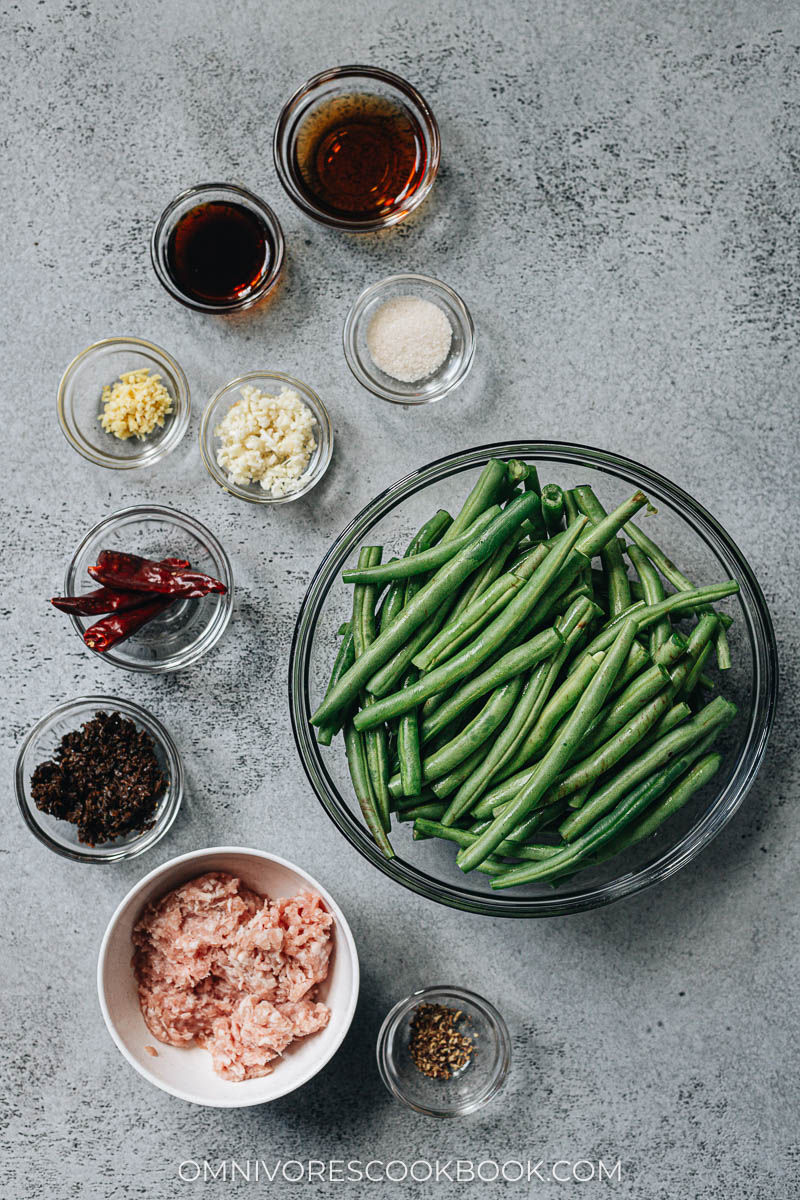
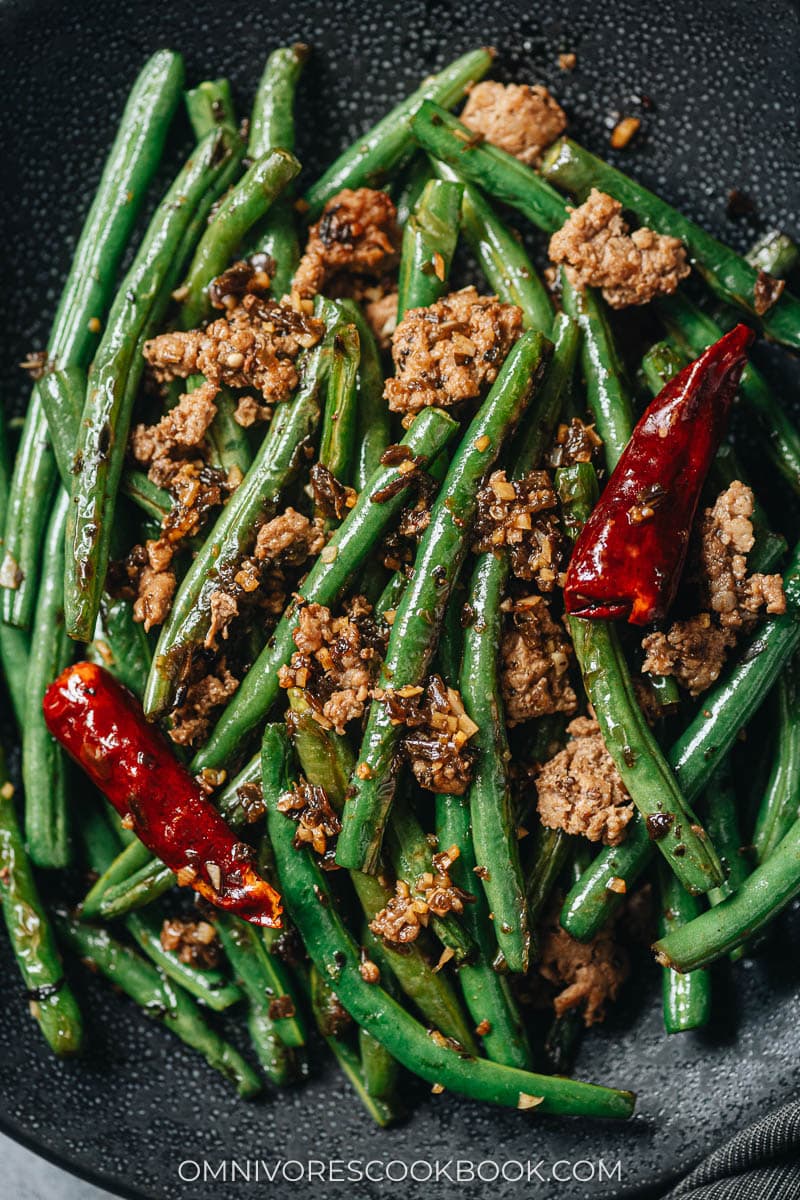
Ground pork is often used in this dish, but I’ve tried it with ground chicken, turkey and beef. They all work really well.
How to cook dry fried green beans
- Pan fry the green beans
- Take out the green beans once they are blistered and just turning tender
- Cook the ground meat, with Sichuan peppercorns and Sui Mi Ya Cai
- Add the aromatics
- Return the cooked green beans to the pan
- Add the rest of the seasonings and stir everything together
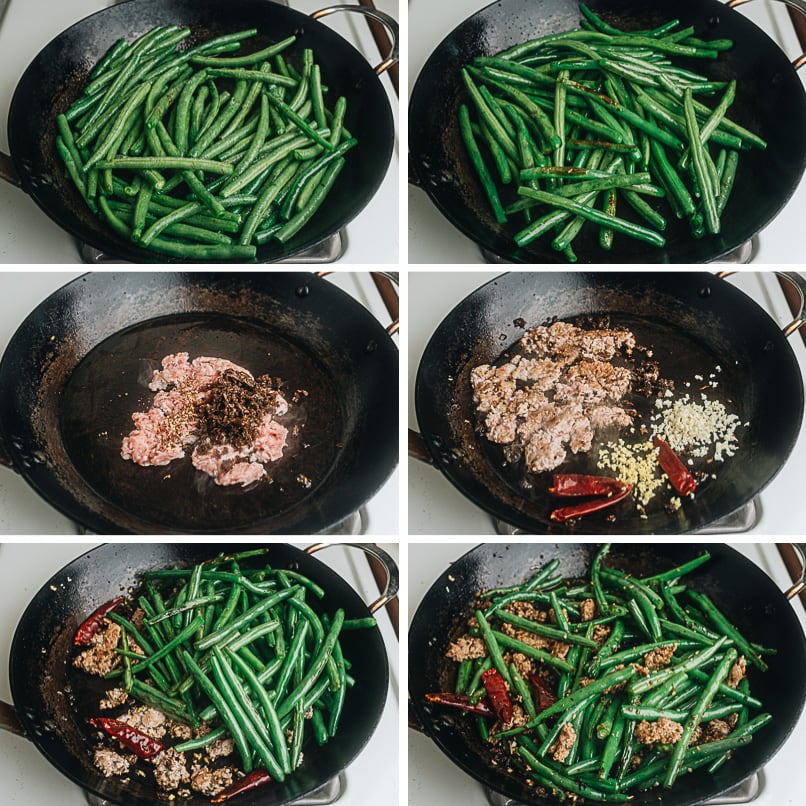
What is dry frying?
Dry frying, or Gan Bian (干煸), is a Chinese cooking technique. It is somewhere between pan searing and deep frying. But it uses less oil, with a longer cooking time, to cook vegetables or meat to slightly dehydrate them, thus creating a crispy and charred surface. The texture of dry-fried vegetables is similar to that of grilled ones, with a hint of smoky flavor.
Seasonings are added after dry-frying; in this recipe, soy sauce, dried chili peppers, and Szechuan peppercorns are used. The withered surface of the green beans holds the spices well, making for an appetizing, intense, and pungent flavor without using a ton of sauce.
How do I make this dish vegetarian / vegan?
The authentic version always uses ground pork as a way to enhance the flavor of the veggies. For a vegetarian alternative, you can choose from minced rehydrated dried shiitake mushrooms, a bit more Sichuan pickled mustard greens, a spoonful of fermented black beans, or some fermented spicy bean paste (the dish will be slightly spicy).
Do I need to use a wok?
Yes and no.
In fact, the first part of the cooking, pan roasting the green beans, works better in a skillet than a wok. It provides a larger contact surface and the beans will be cooked more evenly.
Normally, the second part of the cooking is done in a wok, where you toss the green beans with pork and the rest of the spices. However, I’ve done various experiments and discovered that you can create great results using a skillet, as well. I highly recommend you stay with the skillet, especially if you have an electric stove. For more information, check out why you should stir fry with a frying pan instead of a wok.
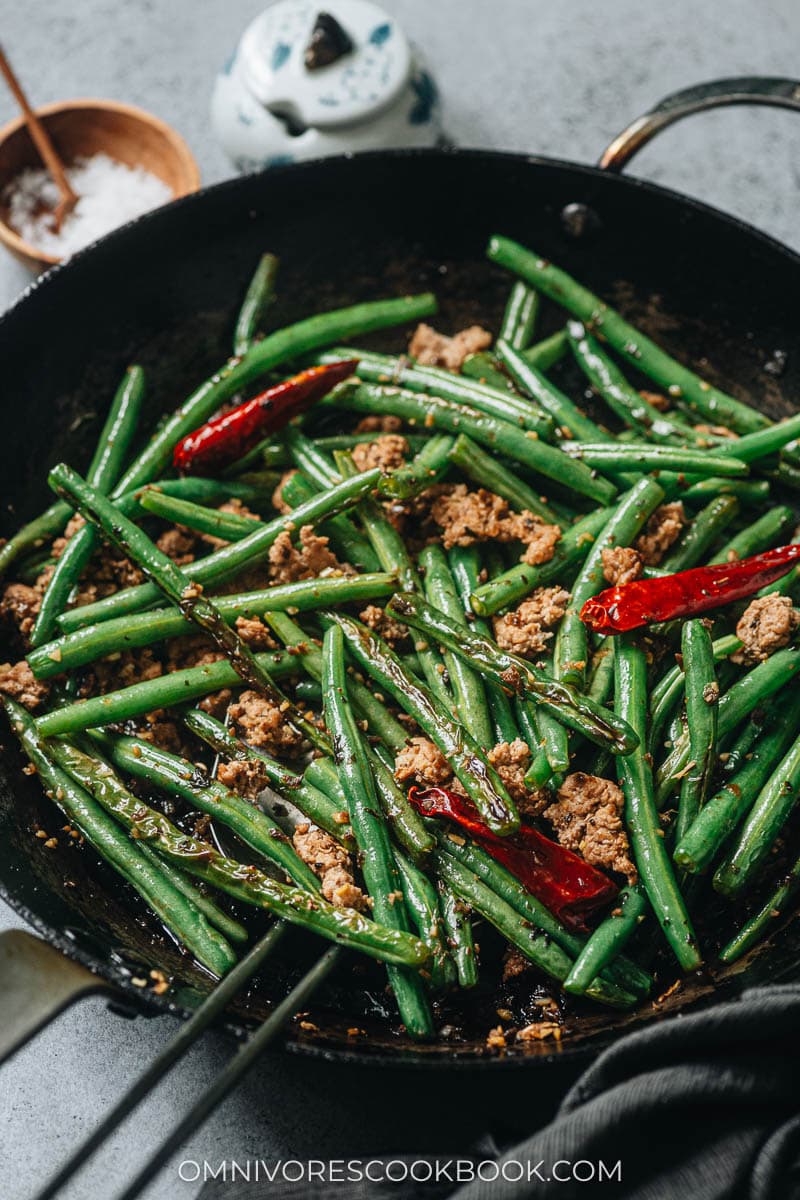
Other delicious Sichuan recipes
- Sichuan Eggplant Stir Fry (鱼香茄子)
- Authentic Mapo Tofu (麻婆豆腐)
- Kung Pao Shrimp (宫爆虾球)
- Chinese Potato Stir Fry (炝炒土豆丝)
- Sichuan Spicy Wonton in Chili Oil (红油抄手)
- Shredded Pork with Garlic Sauce (鱼香肉丝, Yu Xiang Rou Si)
Chinese Cooking Made Easy
Are you new to this website? This free email series is a great place to start. I’ll walk you through a few of my most popular recipes and show you how and why they work. You’ll quickly start to cook better Chinese food in your own kitchen.
Watch video
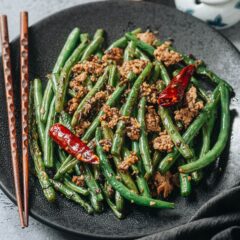
Sichuan Dry Fried Green Beans (干煸四季豆)
Ingredients
- 1 lb green beans , tough ends removed
- 2 tablespoons peanut oil (or vegetable oil)
- 4 oz ground pork (Optional but highly recommended) (*Footnote 1)
- 2 tablespoons Sichuan pickled mustard greens (Sui Mi Ya Cai) (*Footnote 2) (Optional)
- 1/4 teaspoon ground Sichuan peppercorn
- 3 dried chili peppers (*Footnote 3)
- 3 cloves garlic , minced
- 1 teaspoon minced ginger
- 2 tablespoons Shaoxing wine (or dry sherry)
- 1 tablespoon light soy sauce (or soy sauce)
- 1 teaspoon sugar
- Salt to taste
Instructions
- Pat the green beans dry with paper towels to prevent them from splattering.
- Heat 2 tablespoons vegetable oil in a large nonstick skillet over medium-high heat until hot. Add the green beans and a pinch of salt. Stir to coat well with oil. Spread the beans to prevent them from overlapping, as much as possible. Flip every 15 seconds or so. Cook and stir until some of the surface is brown and withered, and the green beans just start to turn soft, 6 to 8 minutes. If you prefer a softer texture, wait until most of the surfaces have charred, 10 to 12 minutes. Turn to medium heat if the pan starts to smoke too much. Transfer the green beans to a plate and set aside.
- Add the remaining 1 tablespoon oil, ground pork, pickled mustard greens, and the ground Sichuan peppercorns. Cook and chop the pork to separate it into small pieces, while mixing with the rest of the ingredients.
- When the surface of the pork has cooked, add the dried chili pepper, garlic, and ginger. Stir a few seconds to release the fragrance. Add back the green beans. Swirl in the Shaoxing wine, light soy sauce, and sugar. Cook and stir until the sauce is mostly absorbed, about 1 to 2 minutes.
- Turn to low heat and carefully taste a green bean with some pork. Adjust seasoning by adding more salt, if needed. Transfer everything to a plate. Serve hot as a side dish or one of the main dishes of a multi-course meal.
Notes
- The purpose of ground pork is to add flavor and texture. It helps a lot, especially when you don’t use the Sui Mi Ya Cai (pickled mustard). You can also use ground chicken or ground beef instead of pork.
If you choose to skip the ground meat, I highly recommend adding Sichuan pickled mustard greens to enhance the flavor. If you do not have Sichuan pickled mustard greens, adding a bit of chicken bouillon, or 2 tablespoons of fermented black beans, or 1 tablespoon of fermented chili bean paste (Doubanjiang) will help develop the flavor too. - Sichuan pickled mustard greens add savory and sweetness to the dish, making it extra rich. If you do not have pickled mustard greens, 2 tablespoons of fermented black beans, or 1 tablespoon of fermented chili bean paste (Doubanjiang) will work great, too.
- The dried chili peppers add a fragrance and smokiness to the dish but not much in terms of heat. If you want the dish to be a bit spicy, break apart the chili peppers before adding them.
Nutrition

Did you make this recipe?
I’d love to hear how it turned out for you! Please take a moment to leave a 5-star rating ⭐️ and share your thoughts in the comments further down the page. It really helps others discover the recipe too.

bill marsano
Could the beans be don e in the broiler?
Maggie Zhu
You definitely can. Actually Serious East has an article on the method and you can see the differences between each method: https://www.seriouseats.com/sichuan-dry-fried-green-bean-broiled-food-lab-recipe
In short, preheat your broiler as hot as you can, place the sheet pan close to the broiler, and broil for 2 to 5 minutes until cooked through.
Jon
Great dish! Have tried with minced pork and very tasty. Have also tried a vegan version with minced rehydrated shiitake fried in a bit of rice wine and soy instead of minced meat, and works a treat!
Audrey Williams
This was a big hit!
Finding some of the ingredients was tough in a rural community but not completely impossible. I substituted Sui Mi Ya Cai with Chili Bean Sauce, but since I didn’t know what the difference was I had to take the word of the man at the market.
Excellent dish. Thanks for offering these recipes. I look forward to making many more.
Quinn
Delicious. Didn’t have ground pork, used spicy pressed tofu, dried shiitake, diced bacon and extra pickled greens.
Corinna Totino
Easy delicious and not cloying sweet or salty. Perfect burn! Will now start following all your recipes